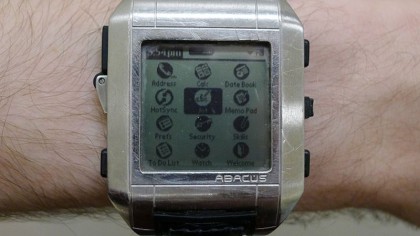The 5 rubbish wearables that actually make Google Glass look cool
Worn out wearables
Xybernaut Poma Wearable PC

Launch date: January 2002
Cost: $1,500 (about £886, AU$1615)
The Xybernaut Poma Wearable PC was another foray into the head-mounted display market that launched way before Google Glass.
The wearable comprised of a 309g Windows CE device, running on the Hitachi 128MHz Risc processor with 32MB of RAM.
Xybernaut offered pocket versions of Internet Explorer, Outlook, Windows Media Player and Word pre-installed and there was an optical mouse to control it, with a colour display mounted on a headband.
The head-mounted monitor allowed you to view 800 x 600 pixel images, giving the impression of a 13-inch monitor.
Hitachi thought people would use the computer to work, surf the Web or play games when they were out of the office or away from home. But with the mini screen in front of one eye it was a little hard to also concentrate on what was happening around you.
Why it should have been awesome: A) the ability to do things you'd normally need to wield a very weight laptop around for, meaning plane trips are much simpler and B) you'd look like a Borg.
Sign up for breaking news, reviews, opinion, top tech deals, and more.
Ultimate reason for failure: Like the Private Eye, the Xybernaut Poma Wearable PC added a lot of bulk to carry around. It wasn't particularly mobile, ran really slowly (even to 2002 standards) and looked a little silly.
Fossil Wrist PDA

Launch date: 2002 (2003 general release)
Cost: $250 (about £148, AU$269)
Fossil's Wrist PDA was essentially a watch running a read-only version of the Palm OS, and received positive reviews when it was first released, with Wired.com calling it "revolutionary".
The Fossil Wrist PDA featured a touch-sensitive 160 x 160-pixel screen with 8MB memory.
There was a stylus that tucked into the strap for input via handwriting recognition or a virtual keyboard and the watch also featured an infrared port for connecting to other Palm devices.
The first edition Fossil Wrist PDA was removed from Fossil's website just a year after it went on sale. The company later released a slimmer design with the Fossil Abacus FX2008 and FX2009 which were on-sale until 2005 when they were all taken off the market.
Why it should have been awesome: Inexpensively bringing the power of the PDA to the wrist, and with a fashion brand attached. In fact, how did Fossil and Palm screw this up?
Ultimate reason for failure: The watch was too bulky, weighed almost as much as a standard PDA and its small, dim screen wasn't particularly useful for everyday use.
Vuzix Wrap 1200DX

Launch date: 2010
Cost: £499.99 (about US$295, AU$538)
Between 2006 and 2011, Vuzix launched a range of projector glasses that allowed you to watch video from your mobile, in widescreen.
Each model allowed you to project videos into the interior eyepieces, giving the impression of watching a film on a TV - anything from 42-inches up to 75-inches - from around 3m away.
The Vuzix Wrap 1200DX was the last model to hit UK shores and the glasses allowed you to stream either 2D or 3D video from any HDMI-enabled device including mobile phones, Blu-ray players, video game consoles, and your computer.
At the top of the range, Vuzix claimed the experience was the same as watching a 75-inch display from 3m away.
Why it should have been awesome: They don't look totally foolish (like other versions of the tech do), and who doesn't want two massive TVs in front of their eyes on the commute to work?
Ultimate reason for failure: The glasses were heavy and let's be honest, who wants to spend their train ride into work with a massive pair of sunglasses on?